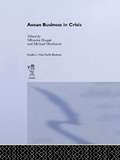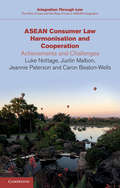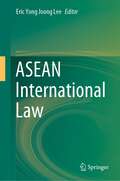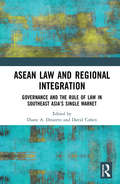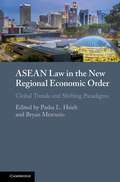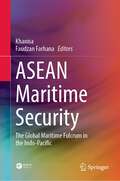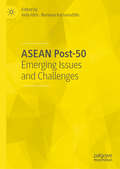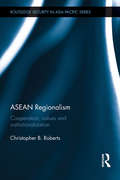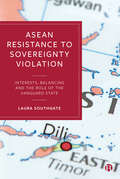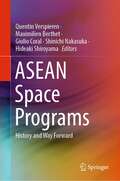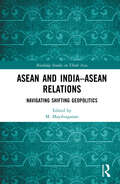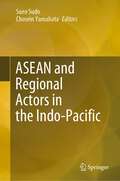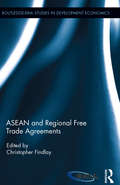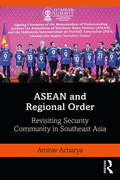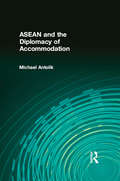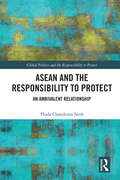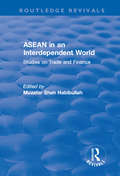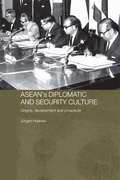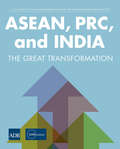- Table View
- List View
ASEAN Business in Crisis: Context and Culture
by Michael Hitchcock Mhinder BhopalThe impact of the Asia crisis has contributed to the debate about the need for regulation of global markets. This book outlines the events leading up to and during the Financial Crisis of 1997 and assesses the responses of the financial contagion.
ASEAN Champions
by Park Seung Ho Ungson Gerardo Rivera Francisco Jamil Paolo S.With a population of about six hundred million people, and a combined GNP of more than US$ 2. 4 trillion, the ASEAN Economic Community (AEC) is set to become the seventh largest economy in the world. Launched in December 2015, the AEC unveiled initiatives to create a single market and production zone, a competitive and equitable region, and integrated links to the global economy. ASEAN Champions seeks to address the role of the strong local firms in regional integration, how these 'champions' succeeded and endured, despite facing adverse circumstances, and the factors that facilitated or impeded their participation in regional integration. The book provides insights for future firm and government-led strategies to enhance the integration process. By complementing current narratives that focus on macroeconomic, socio-political, and trade considerations, Park, Ungson and Francisco offer an enlightening and engaging read, ideally suited to academics and professionals alike.
ASEAN Consumer Law Harmonisation and Cooperation: Achievements and Challenges (Integration through Law:The Role of Law and the Rule of Law in ASEAN Integration #18)
by Caron Beaton-Wells Justin Malbon Luke Nottage Jeannie PatersonThis is the first Western-language research monograph detailing significant developments in consumer law and policy across the Association of Southeast Asian Nations (ASEAN), underpinned by a growing middle class and implementation of the ASEAN Economic Community from 2016. Eight chapters examine consumer law topics within ASEAN member states (such as product safety and consumer contracts) and across them (financial and health services), as well as the interface with competition law and the nature of ASEAN as a unique and evolving international organisation. The authors include insights from extensive fieldwork, partly through consultancies for the ASEAN Secretariat, to provide a reliable, contextual and up-to-date analysis of consumer law and policy development across the region. The volume also draws on and contributes to theories of law and development in multiple fields, including comparative law, political economy and regional studies.
ASEAN Industries and the Challenge from China
by Anthony Welch Darryl S.L. JarvisThis book explores the impact of the rise of China on South East Asia, addressing the consequences for some of Asia's key economic sectors, including educational services, bio-technology, financial services, and the food industry, among others.
ASEAN International Law
by Eric Yong Joong LeeThis book consists of updated and refreshed papers written by international law scholars and practitioners from the ASEAN region and published by the Journal of East Asia and International Law, comprehensively covering almost all contemporary international legal issues related to ASEAN.Legal analysis of the ASEAN integration as one community with one vision in this book provides readers with a better understanding of the current social climate and future developments of ASEAN. Each section within the book covers a highly topical issue on ASEAN cooperation and dispute resolution from an international law perspective. ASEAN is one of the biggest economic communities in the world and the ASEAN+3 covers nearly half of global GDP. Given the region’s global impact, this book is of interest to Asia watchers, academics and policymakers alike.
ASEAN Law and Regional Integration: Governance and the Rule of Law in Southeast Asia’s Single Market
by Diane A. DesiertoSince the passage of the ASEAN Charter in 2008, ASEAN has transformed itself from a loose economic cooperation, into a formal intergovernmental organization designed to create an “ASEAN Community” forged together in three pillar communities – the ASEAN Political-Security Community, ASEAN Economic Community, and tASEAN Socio-Cultural Community. Forty years of pre-Charter ASEAN practices, coupled with over ten years of post-Charter ASEAN practices thus far, has witnessed the conclusion of hundreds of legally binding regional treaties and similarly binding international instruments in all areas of economic, political-security, and socio-cultural concerns for Southeast Asia to achieve ASEAN’s rule of law-based development objective. Pre-Charter and post-Charter ASEAN Law is variably implemented under a hybrid governance system that depends heavily on ASEAN Member State national implementation alongside ASEAN’s evolving regional institutions. The result is not a model of deep integration as in the case of the European Union, but a particular paradigm of horizontal embeddedness of ASEAN Law – in all its norms and operational practices – contingent on the capacities and compliance of national government bureaucracies in Southeast Asia. This edited collection is a concise authoritative volume covering the practical, doctrinal, legal, and policy aspects of the new regime of ASEAN Law and its consequences for realizing rule of law-based development in Southeast Asia’s emerging single market and production base. Drawing together contributions from a range of key thinkers in the field, the editors present the legal and policy-making issues implicated in the practical implementation of Southeast Asia’s single market and its regime for the free movement of goods, services, foreign investment, and cross-border labor. The book also examines the nature of regional law-making under ASEAN before and after the commencement of regional integration in 2015, the nature of ASEAN’s economic regulators, as well as the evolving structure for enforcement and harmonization of “ASEAN Law” through the array of Southeast Asian national courts, arbitral tribunals, and incipient mechanisms for inter-State, intra-regional, and individual-State conflict management and dispute resolution. This book is highly relevant to students, scholars, and policy-makers with an interest in ASEAN Law and regional policy, and to Southeast Asian studies in general.
ASEAN Law in the New Regional Economic Order: Global Trends and Shifting Paradigms
by Bryan Mercurio Pasha L. HsiehThe fast-growing last decade of strong economic growth of the Association of Southeast Asian Nations (ASEAN) has played a critical role in Asia-Pacific regionalism and global trade. This book explores the concept of ASEAN law under the normative framework of the new regional economic order. It examines the roadmap of the new ASEAN Economic Community Blueprint 2025 by evaluating the impact of ASEAN trade agreements on domestic legislation on professional services, financial integration, investment disputes and digital trade. More importantly, it sheds light on the legal implications of ASEAN's agreements with China and India and the potential developments of mega-regional trade agreements such as the CPTPP and the RCEP. Hence, the legal analysis and case studies in the book offer a fresh view of Asia-Pacific integration and bridge the gap between academia and practice.
ASEAN Maritime Security: The Global Maritime Fulcrum in the Indo-Pacific
by Khanisa Faudzan FarhanaThis book covers various strategic issues around maritime security in terms of how Indonesia has sought to implement its Global Maritime Fulcrum (GMF) vision, evaluating its regional impact within ASEAN. The Global Maritime Fulcrum’ vision was declared by President Joko Widodo to refocus Indonesia’s development paradigm to prioritize its maritime aspect in the Indo-Pacific. Divided across five pillars, namely: maritime culture, maritime resource management, maritime infrastructure and connectivity development, maritime diplomacy and maritime defense, the book presents that the implementation of this vision will doubtless have a significant regional impact, particularly in setting regional maritime agendas. In promoting an understanding of the challenges presented in implementing the Global Maritime Fulcrum and unpacking its multifaceted impact in the region, this book delves into Indonesia’s maritime vision, the existing maritime arrangements within ASEAN, and Indonesia’s interests in terms of its political economy relating to the maritime sector, strategic security issues, maritime diplomacy, and related regional power dynamics. Translated from Bahasa Indonesia into English, the book is relevant to scholars and policymakers in maritime studies, international relations, and regional studies relating to politics and power dynamics in Indonesia, specifically, and ASEAN more broadly.
ASEAN Post-50: Emerging Issues and Challenges
by Aida Idris Nurliana KamaruddinThe first 50 years of ASEAN integration has brought peace and prosperity to the Southeast Asian region, while the next 50 will undoubtedly be fraught with unprecedented challenges. Today ASEAN not only has to contend with its own internal challenges arising from the highly diverse political, economic and socio-cultural systems of its member countries, it also has to deal with external factors which include shifts in geostrategic balance, fraying global consensus on free trade, populism and xenophobia, climate change, digital revolutions and cybercrimes.Set against the above background, this edited collection considers some of the contemporary issues and challenges faced by ASEAN in its journey towards more cohesive and dynamic regional integration. Among the topics explored are ASEAN’s evolving partnerships with its key strategic partners including China and the United States on economic policies and strategies, educational systems and frameworks, migration and environmental threats.
ASEAN Regionalism: Cooperation, Values and Institutionalisation (Routledge Security in Asia Pacific Series)
by Christopher B. RobertsThis book examines the key motivations for and challenges to greater regional integration in Southeast Asia. It demonstrates how security and economic concerns -domestic, regional and international - have either contributed to, or detracted from, an increased level of unity and cooperation in ASEAN. It also explores how the patterns of interaction and socialization generated by these issues, together with the nature of domestic political systems, have affected the emergence of common values, norms and interests. It covers the full range of issues confronting ASEAN at present, and the full range of ASEAN countries, and discusses both developments in ASEAN to date and also likely future developments.
ASEAN Resistance to Sovereignty Violation: Interests, Balancing and the Role of the Vanguard State
by Laura SouthgateAvailable Open Access under CC-BY-NC licence. Examining how the Association of Southeast Asian Nations’ (ASEAN) has responded to external threats over the past 50 years, this book provides a compelling account of regional state actions and foreign policy in the face of potential sovereignty violation. The author draws on a large amount of previously unanalysed material, including declassified government documents and WikiLeaks cables, to examine four key cases since 1975. Taking into account state interests and the role of external powers, the author develops the ‘vanguard state theory’ to explain ASEAN state responses to sovereignty violation, which, it is argued, has universal applicability and explanatory power.
ASEAN Space Programs: History and Way Forward
by Hideaki Shiroyama Quentin Verspieren Maximilien Berthet Giulio Coral Shinichi NakasukaThis book presents the first-ever comprehensive analysis of ASEAN space development programs. Written by prominent actors in the region, it goes beyond a mere exposé of the history, current status and future plans of ASEAN space technology development and utilization programs, by analyzing the conditions in which a space program can be initiated in the region. It does so in two ways: on the one hand, it questions the relevance of and motivations behind the inception of space development programs in developing countries, and on the other hand, it focuses on the very specific context of ASEAN (a highly disaster-prone area shaped by unique political alliances with a distinctive geopolitical ecosystem and enormous economic potential, etc.). Last but not least, after having analyzed established and emerging space programs in the region, it provides concrete recommendations for any regional or extra-regional developing nation eager to gain a foothold in space. As such, this book offers a valuable resource for researchers and engineers in the field of space technology, as well as for space agencies and government policymakers.
ASEAN and India–ASEAN Relations: Navigating Shifting Geopolitics (Routledge Studies on Think Asia)
by M. MayilvagananThis book analyses the nearly 30 years of India–ASEAN relations from a contemporary perspective, identifies the reasons for India’s vibrant and significant relation with ASEAN and examines the cultural, economic, political and strategic linkages between India and ASEAN. The book projects the future of India–ASEAN relations in the face of the changing Indo-Pacific geopolitics and explores potential policies which could enhance the connection between India and Southeast Asian countries. Arguing that ASEAN is of primary importance to India, the book suggests that any successful outing in the Indo-Pacific would need a strong partnership with India. The book demonstrates how external powers influence ASEAN, with many of them supporting the centrality of ASEAN and its regional architecture in the broader Indo-Pacific. Chapters by experts in their fields present thematically specific analyses of political, defence, maritime and cultural aspects as well as the position of Northeast India in the India–ASEAN relations and assess the success and challenges of India’s ties with ASEAN in the context of the Look East and the Act East Policies. A reassessment of ASEAN–India relations past and present, this book will be of interest to academics and policy makers working in the field of International Relations, Asian Politics and South Asian Politics, in particular India’s Foreign Policy and Southeast Asian Politics.
ASEAN and Power in International Relations: ASEAN, the EU, and the Contestation of Human Rights (Routledge Contemporary Southeast Asia Series)
by Jamie D. StaceyThis book analyses the Association of Southeast Asian Nations (ASEAN) as a powerful actor in International Relations by examining how the ASEAN community has evolved, looking specifically at its relationship with the EU with regards to human rights. The book adds to important contemporary debates within constructivist theory, shedding light on the need for ‘critical’ constructivism that emphasises language and contestation and what that may entail. On an empirical level, it challenges the idea of an 'EU-centrism,' demonstrating how ASEAN is the major driving force behind its human rights and community aspirations, as well as within the ASEAN-EU relationship. Furthermore, this book engages with the introspection surrounding constructivism by addressing the trouble with 'norms,' and instead unpacking the relationship between ASEAN and the EU to show language power in play. In particular, the book looks at how language, or rather coercive language, helps us ‘see’ contestation in action, something that researchers sympathetic towards the idea of ASEAN’s ‘resistance’ have been unable to show through a focus on norms. Tracing the evolution of the ASEAN community and human rights aspirations in a new light, showing how exactly the EU remains an inspiration, but not a model, and more interestingly how ASEAN demonstrates power in the relationship, the book will be of interest to academics working on Asian Studies, European Studies, International Relations Theory and human rights.
ASEAN and Regional Actors in the Indo-Pacific
by Sueo Sudo Chosein YamahataThis book discusses the shifting regional geopolitical engagements and development of rearranged connections emerging among ASEAN and non-ASEAN actors.First, the book focuses on the crucial discourse surrounding the Indo-Pacific region, including its challenges, continuity, and relevance. The discussion highlights the growing influence of regional actors such as India, Thailand, Japan, and the US, particularly in the context of a pressing question of collaboration versus containment amidst China’s rise. The book delves into various topics, such as geopolitical anxieties, economic strength, foreign policy, international relations, development, and security promotion in South and Southeast Asia, through the lenses of ASEAN centrality and the Indo-Pacific strategy.Second, the volume emphasizes on the escalating tensions and the worsening crises in the region that cause major anxieties and the subsequent realignment and new alignment of countries’ relationships. Among several chapters of the volume, a large Indo-China state, Myanmar, takes a special place in the book’s discussions as it has grown as an important ground for a resource/energy race among geopolitically strategic partners. Additionally, Myanmar has the potential to become a balancer in ASEAN. Therefore, any positive development and change in course of relations to Myanmar, particularly with its neighbors, Japan, and Russia, in both historical and contemporary contexts, can have a significant impact not only on Myanmar’s course towards peace, democracy, and security, but also regional stability. The editors and contributors examine the unique position of ASEAN, with a focus on ASEAN centrality as a platform for addressing anxieties and building relationships to bridge the gap between world and regional players, including both friends and foes.Overall, the volume provides valuable insights into the Indo-Pacific region’s complex dynamics, including cooperation and collaboration among regional actors for long-term stability and prosperity. The interdisciplinary composition of the book invites readers from various backgrounds to engage with constructive debates on general perception, contextual discussion, and the highlights of engaged research from local and international perspectives.
ASEAN and Regional Free Trade Agreements (Routledge-ERIA Studies in Development Economics)
by Christopher FindlayEfforts to use existing trade agreements to build a larger regional agreement face many challenges. This book considers this problem with reference to ASEAN’s current agreements with key partners and the interest to build the Regional Comprehensive Economic Partnership (RCEP). The analysis of the options is framed by a focus on the use of supply chains in international business. Issues considered include those related to reductions in tariffs, trade facilitation, the treatment of investment and of services and the definition of rules of origin. The work is informed by case studies of supply chains in automobile and electronics, and in a professional service sector. The book provides a set of priority actions for better progress in taking a bottom-up approach to building RCEP.
ASEAN and Regional Order: Revisiting Security Community in Southeast Asia (Politics in Asia)
by Amitav AcharyaFounded in 1967, the Association of Southeast Asian Nations (ASEAN) has emerged as one of the most successful regional organizations in the world. This book discusses the future of ASEAN against a backdrop of a growing US–China rivalry and the security implications of COVID-19. Chapters in this book move through a history of ASEAN and its multilateral institutions, including the ASEAN Regional Forum (ARF) and the East Asia Summit (EAS), featuring rare photographic material to contextualize both recent developments in regional security and projections for ASEAN’s prospects. Key concepts and terms are unpacked throughout, with the chapters focusing on rapidly changing international and regional environments, economic insecurities such as trade conflicts, human rights, and ASEAN identity, and providing extensive analysis of the factors challenging the principle ASEAN Centrality and the Indo-Pacific security architecture. The concept of security community frames this book, despite being subject to change if intraregional discord and institutional stagnation take hold. As a discussion of the role and future of ASEAN in a pivotal period of world history, ASEAN and Regional Order will prove vital to both students and scholars of international relations, regional organizations, and Asian studies more broadly.
ASEAN and the Diplomacy of Accommodation
by Michael AntolikThis book studies the activities undertaken by the ASEAN states and reflects the inspiration and support of many individuals. The ASEAN phenomenon is about the successful consultative process, the accommodation, that these states used in managing tensions and dealing with external environments.
ASEAN and the Institutionalization of East Asia (Routledge Security in Asia Pacific Series)
by Ralf EmmersThis book examines the evolving multilateral security arrangements in East Asia, with a focus on the role of the Association of Southeast Asian Nations (ASEAN). It explores the function and relevance of ASEAN in East Asia's emerging institutional security landscape. These issues have direct implications for the future of the ASEAN Security Community, the relevance of the ASEAN cooperative model to wider regional arrangements, and finally, for the further institutionalization of great power relations within these multilateral structures. The book highlights ASEAN's successes and shortcomings. It also considers ASEAN-led institutions in the wider region and goes on to analyse alternative approaches to regionalism, including the China-Japan-South Korea Trilateral Summit. Overall, it assesses how the various initiatives are likely to develop, concluding that ASEAN, despite its shortcomings, is likely to continue to play a key role.
ASEAN and the Responsibility to Protect: An Ambivalent Relationship (Global Politics and the Responsibility to Protect)
by Thida Chanthima NethThis book adopts a sociolegal and interdisciplinary approach to examine how the Responsibility to Protect (R2P) has been understood within the Association of Southeast Asian Nations (ASEAN).Historically, the international community has struggled to effectively address humanitarian crises worldwide. The concept of the 'Responsibility to Protect' (R2P) has emerged over the past two decades as a principle that could guide states’ efforts to prevent and respond to humanitarian crises. However, R2P's interpretation varies across different regions, and it remains to be established whether it can successfully achieve its goals. This book adopts an interdisciplinary approach to analyse how R2P has been perceived and applied within the Association of Southeast Asian Nations (ASEAN) and China. In particular, it explores ASEAN’s, ASEAN member-states’ and China’s understanding and implementation of R2P, paying special attention to the 1999 East Timor crisis, the Rohingya crisis, and the West Papua conflict. The book assesses whether R2P has influenced the actions of ASEAN, its member states, and China. At a broader level, the book also explores regional approaches to international law, shedding light on Southeast Asian states’ perspectives on this aspect of global governance.This book will be of much interest to students of Responsibility to Protect, Asian politics, human rights, international law, and International Relations in general.
ASEAN and the Security of South-East Asia (Routledge Revivals)
by Michael LeiferProblems of internal and external security in South-East Asia have persisted as one set of competing global alignments has been succeeded by another, with major impact on regional relationships. This book, first published in 1989, examines how the states of The Association of South-East Asian Nations (ASEAN) have attempted to confront the problems of regional security. It considers the nature and role of the Association - intended to promote economic growth, social progress and cultural development - traces its institutional development from 1967 and identifies a basic structural weakness arising from the differing strategic perspectives held by member governments. Leifer explores in particular ASEAN’s response to conflicts over Kampuchea, renamed Cambodia in 1990, which was critical in exposing those differing perspectives and the limited role of a diplomatic community in coping with regional security problems. This comprehensive work will be of particular value to students and academics with an interest in South-East Asian diplomacy, history and regional security.
ASEAN as a Method: Re-centering Processes and Institutions in Contemporary Southeast Asian Regionalism (Politics in Asia)
by Ceren ErgençThis edited volume proposes that an understanding of ASEAN – its development and institutionalization – is invaluable to our conception of international relations theory in the Asian context. Southeast Asia and ASEAN host peoples, ideas, institutions, and relations that contribute to a critical reassessment of theories in social sciences. In the field of IR, studies on transnational networks, diasporas, small states, middle powers, the role of history, and identity learn from Southeast Asian practices. ASEAN has long been established as an authoritative example of alternative ways of regional institutionalization. Besides empirical analysis, these fields can also benefit from their interactions with regional scholarly communities. This edited book offers an opportunity for a dialogue among scholarly communities on a variety of issues of which Southeast Asia and ASEAN provide ample opportunities for a critical analysis. This book will be of great interest to scholars of ASEAN, the broader Asian region, and for scholars of regionalism in general.
ASEAN in an Interdependent World: Studies in an Interdependent World (Routledge Revivals)
by Muzafar Shah HabibullahThis title was first published in 2000. This volume contains nine selected applied economic papers presented during the 1999 Faculty of Economics and Management Seminar in Melaka. The articles included focus the studies on trade and finance in Malaysia and other ASEAN member countries.
ASEAN's Diplomatic and Security Culture: Origins, Development and Prospects
by Jurgen HaackeMember states of ASEAN - the Association of South-East Asian Nations - have developed a distinctive approach to political and security co-operation, which builds on the principles of sovereign equality, non-intervention and non-interference, quiet diplomacy, mutual respect, and the principle of not involving ASEAN in mediating bilateral disputes among the membership.This book examines the origins of ASEAN's diplomatic and security culture and analyses how over time its key principles have been practised and contested as ASEAN states have responded to regional conflicts as well as challenges posed by the major regional powers, ASEAN's enlargement, and the Asian financial crisis. The book goes on to assess whether ASEAN's diplomatic and security culture is likely to remain salient as the political, economic and security context in which regional leaderships operate is undergoing further change.
ASEAN, PRC, and India: The Great Transformation
by Adbi AdbAsia's remarkable economic performance and transformation since the 1960s has shifted the center of global economic activity toward Asia, in particular toward the Association of Southeast Asian Nations (ASEAN) economies, the People's Republic of China, and India (collectively known as ACI). While these dynamic developing economies do not form any specific institutional group, they constitute very large economies and markets. These emerging Asian giants share common boundaries, opportunities, and challenges. Their trade, investment, production, and infrastructure already are significantly integrated and will become more so in the coming decades. This book focuses on the prospects and challenges for growth and transformation of the region's major and rapidly growing emerging economies to 2030. It examines the drivers of growth and development in the ACI economies and the factors that will affect the quality of development. It also explores the links among the ACI economies and how their links may shape regional and global competition and cooperation.
